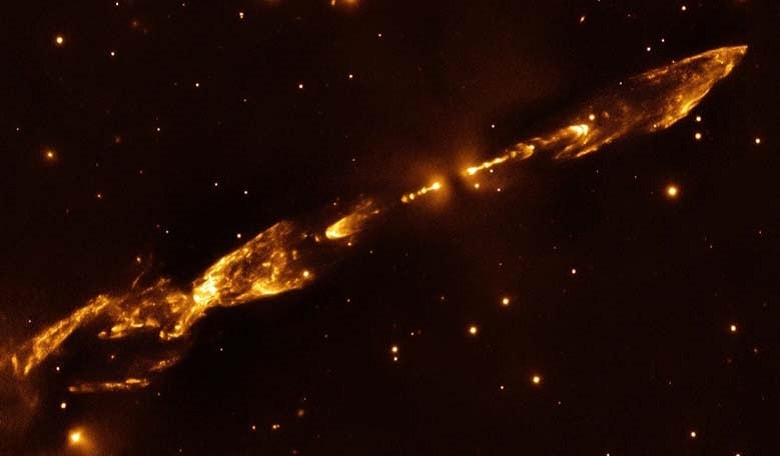Hot corinos, a possible integral link in the stage of star formation has been detected in Orion for the first time, giving astronomers an insight into how stars such as our Sun might be formed.
Making stars is a tricky business as a collapsing gas cloud has to compete with many different energetic phenomena whose very nature is to disrupt their immediate surroundings. Or could it be, that these phenomena such as winds and jets are the key to successfully aiding the formation of a protostar and its circumstellar disk?
As a circumstellar disk and its central protostar evolves, the system is subjected to angular momentum and magnetic fields that can lead to substantial episodes of matter ejection through processes yet to be conclusively determined. On the other hand the gravitational energy released as a giant molecular cloud collapses heats up the material surrounding the developing protostar, creating warm regions (?100 K) enriched by complex organic molecules (COMs). These regions are known as hot corinos and to date less than a handful of these objects that are populated with COMS, have been observed on scales less than 100 astronomical units (AU) – one AU is roughly the distance from Earth to the Sun.
The complex interplay between these processes has left many unanswered questions, however the recent detection of a hot corino, the first to be detected in Orion by a team of astronomers, could help researchers piece together how stars such as our Sun are formed.
In a recent paper submitted by C. Codella from INAF, Osservatorio Astrofisico di Arcetri in Italy, the team explain their detection of two compounds used to identify hot corino’s, namely heavy water (HDO) and acetaldehyde (CH3CHO) found in the inner region, ~100 AU of HH212 . This very young protostellar system is hidden in a rotating and infalling envelope and is the only protostar where both a bright bipolar jet and a compact rotating disk have been revealed. Given its association with all the ingredients of the Sun-like star formation recipe, the authors note that HH212 stands out as being the perfect target for investigating the link between hot corinos, circumstellar disks, and outflows in the protostellar stage.
Using the high sensitivity, high angular resolution, and large bandwidth offered by the Atacama Large Millimetre/Submillimetre Array (ALMA) to probe the inner region of HH212, the team confirm that the detected acetaldehyde abundance is similar to that measured in hot corinos located in low-mass star forming regions in Ophiuchus. In addition the HDO emission detected by the team, indicates that at least some of the deuterated (heavy) water is associated with slow out-flowing gas.
On the path of evolution of solar-type stars, the Class 0 phase is the main accretion phase during which most of the final stellar mass is accreted onto the central protostellar object. Since most COMs are released from dust grains, it is suggested that the COMs are predominantly associated to the protostellar envelope and not to a protostellar disk (progenitors of the protoplanetary disks observed at later stages) and are released in the warm inner envelope around the central protostellar object. If the COM emission indeed traces the warm inner envelope heated by the central protostellar object, COM lines could be good candidates to study the infall and accretion of circumstellar material down to the very vicinity of the protostellar object itself.
However, it has also been proposed that COM emission could originate from the warm surface of embedded disks or shocked material along protostellar jets, as species such as acetaldehyde are known to be greatly enhanced in shocks as a result of grain mantle sputtering.
The team states that their findings on HH212 support chemical enrichment of a low-velocity outflowing gas heated by the protostar in its surroundings. Analysis of the emission suggests the region in which this gas is located is very small (? 20–40 AU) and extremely dense. With such extreme sizes and densities, the team state it is tempting to speculate that the observed gas may be associated with a disk wind gas accelerated at the base. The team also note that the occurrence of a wide-angle flow in HH212 with a nested onion-like velocity structure has recently been suggested by other observations of the compound carbon monosulfide (CS), also taken with ALMA, thus adding weight to this suggestion.
These findings hence point to these particular COM emission lines as tracing winds and outflowing material, not infalling material onto the protostar, a scenario favoured by previous studies. It is likely therefore that further observations are required to see if other hot corinos follow suit.
Further information on this paper can be found here arxiv.org











